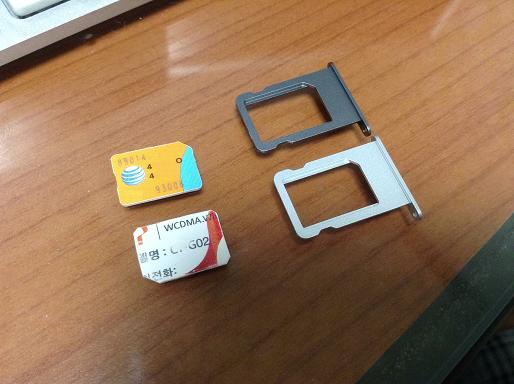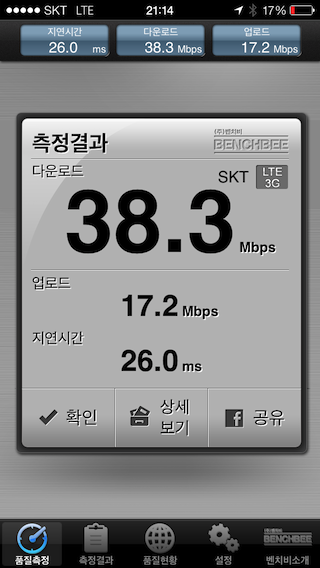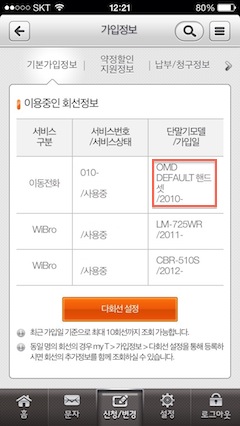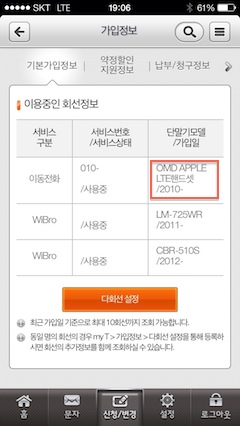Making iPhone 5S work on a Korean network
Posted by Wesley on
Free AT&T SIM found inside iPhone 5S
UPDATE (Sept. 25, 2014): There has been some changes in activating LTE devices from overseas in Korea. [Read the related iPhone 6 Plus review.]
When my friend Andy lined up to get the new iPhone 5S, the Apple Store had specific supplies of the phone for each of the four major U.S. carriers. If three of the carriers supposedly use the same model as seen in Apple's website, it might seem strange that this division existed. It turns out that each of the phones have a SIM card for the designated carrier, as well as some specific device status configured (SIM lock, CDMA enable). As you can see, Andy got me an AT&T version of the iPhone 5S with model number A1533, with the AT&T NanoSIM as a proof.
Now, Apple mentions that the model number of the iPhone 5S planned to be released in Korea is A1530, which forgoes the AWS and 700MHz bands used in North America and instead supports TD-LTE bands used in places like China. Interestingly, both models (as a matter of fact, all models) support LTE bands currently active in Korea, so it seemed likely that A1533 iPhone 5S would be able to hop onto LTE networks in Korea. This was the reason I risked buying A1533 outright instead of trying to get A1530 from Hong Kong or wait for official Korean release. It turns out my hunch was correct, but it's not completely plug-and-play. Read on to minimize the chances of bumping into problems.
If any of the enterprising Koreans (or expats living in Korea) wants to get into iPhone 5S action early in Korea and is visiting U.S. or asking someone there to get one, one should make sure to buy the phone straight from an Apple Store, without contract and paid in full. Andy bought the AT&T version in this manner and it turned out to be carrier unlocked. I received the sealed phone package from him knowing that he didn't have to do anything to get it unlocked first.
If you decide to reserve one from online U.S. Apple Store, the T-Mobile version is offered in contract-free, unlocked state from the get-go, so this should be a good bet as well. Verizon version's SIM slot is said to be unlocked regardless of where you get it, so this is another good option. Sprint version, on the other hand, seems unclear on the lock status, so you should try to get the other version first, if you can.
With the unlocked iPhone 5S in my hands, I removed the NanoSIM issued by SK Telecom (SKT; #1 mobile carrier in Korea) from my iPhone 5 and inserted it into the 5S. After a few moments, the network recognized the new device and I was able to immediately use the 3G connection. However, LTE was out of question at this point. This was because the network knew that the phone was 3G-capable from the acceptance of the SIM, but the specific phone model nor its IMEI were not in its database, so it couldn't tell if it was LTE-capable. As a result, it assigned a generic model name to its database, which reads as "OMD DEFAULT Handset".
To make the device work with LTE, I paid a visit to one of the branch offices of SKT. I explained to the customer service that this new iPhone that I bought in the U.S. is compatible with SKT's LTE network, and wanted the network to recognize it as such. At first, the service agent thought I brought an iPhone 5 and asked if the model was A1428 or A1429. I told the person that this was the newer model of the iPhone series that has not yet been released in Korea. The agent eventually entered the device's IMEI into the database and asked for the central office to authorize the device as an LTE-capable unit. This took about 15 minutes, and after this was done, it worked on the network flawlessly as an "OMD APPLE LTE Handset".
I then wanted to register my iPad mini and iPhone 3GS under the "shared data" plan tied to the iPhone 5S's LTE plan. Unfortunately, the agent told me that this was possible only on weekdays (I visited the office on Saturday). I was able to register them the following Monday without issues.

Connection speed test at Suwon
Then I ran a few speed tests to see how good the LTE connection was. I was pleased to see that it was getting nearly 40Mbps. I was only able to get about 10Mbps with 3G in the best conditions at the same location. With the network setup complete, I moved onto testing the improved parts of the new iPhone.


